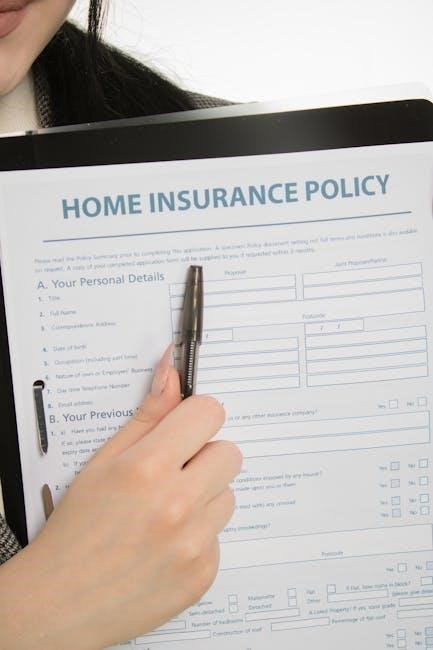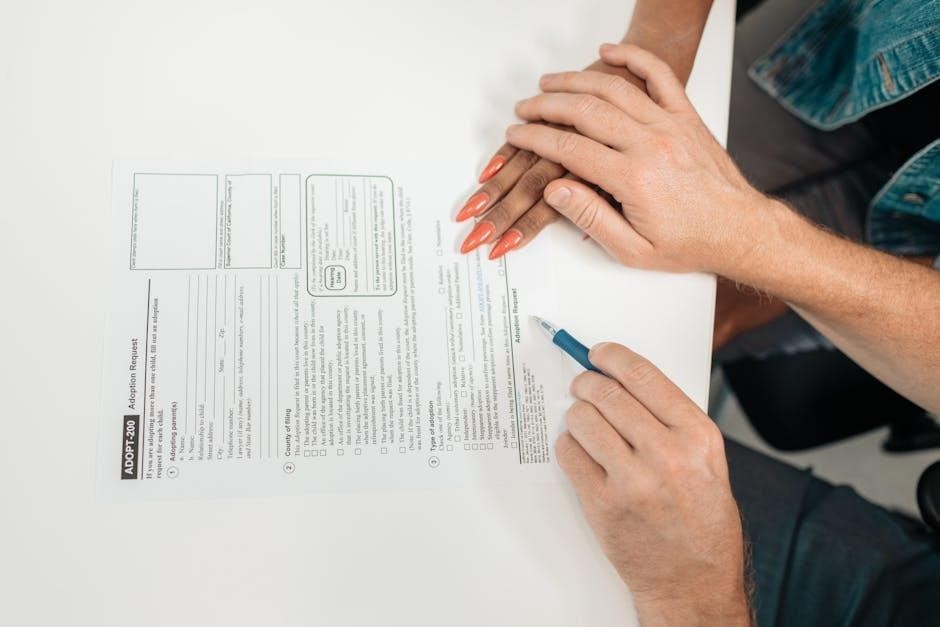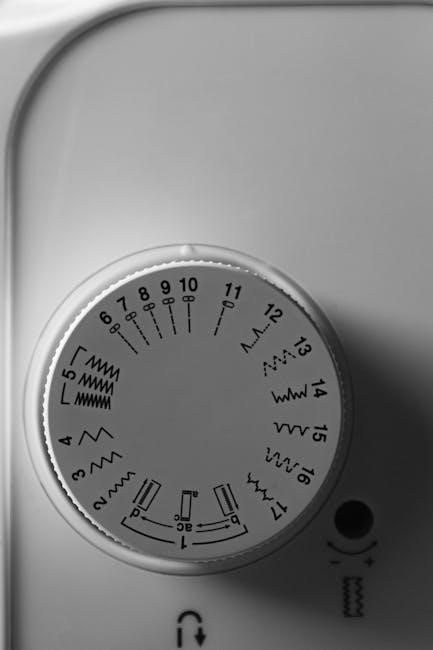Form 410 is a standardized rental application used in Ontario, designed to streamline tenant screening. It collects personal, financial, and rental history details, ensuring a comprehensive evaluation process for landlords while maintaining legal compliance and fairness for tenants.
1;1 Overview of Form 410
Form 410 is a standardized rental application form designed for use in Ontario, Canada. Created by the Ontario Real Estate Association (OREA), it serves as a comprehensive tool for landlords to evaluate potential tenants. The form is fillable, allowing applicants to input personal, financial, and rental history details efficiently. It includes sections for applicant information, employment history, credit details, and references. This document is widely used in the province to ensure a fair and transparent tenant screening process. Its structured format helps landlords assess applicants consistently while maintaining compliance with Ontario rental laws. Form 410 is essential for streamlining the rental application process.
1.2 Purpose of the Rental Application
The primary purpose of Form 410 is to provide landlords with a structured tool to evaluate potential tenants. It ensures a fair and consistent assessment of applicants by gathering essential information, such as personal details, employment history, financial status, and rental background. This helps landlords make informed decisions while adhering to Ontario rental laws. The form also promotes transparency, as it requires applicants to disclose relevant information upfront. By standardizing the application process, Form 410 reduces subjectivity and ensures compliance with legal requirements. It serves as a vital document for both landlords and tenants, fostering a clear and professional rental agreement process.
1.3 Structure of the Form

Form 410 is divided into sections designed to collect specific information. It begins with applicant details, including names, contact information, and employment status. Subsequent sections request financial data, such as income sources and bank account details. Rental history is also documented, with fields for previous landlords and references. The form includes a section for declaring criminal history and any past evictions. Additionally, there is an area for applicants to provide additional information. The structure ensures a logical flow, making it easy for applicants to complete and for landlords to review. Each section is clearly labeled, promoting clarity and reducing the likelihood of incomplete submissions. This organized approach helps streamline the rental application process for all parties involved.
1.4 Key Features of the Fillable Form
Form 410 is available as a fillable PDF, enabling applicants to complete it digitally. The form includes interactive fields for easy data entry, reducing errors. It supports electronic signatures, allowing for quick submission. The fillable version is accessible on platforms like PDFLiner and DocHub, where users can edit, sign, and share the document. The form retains its professional structure while offering flexibility. Applicants can save their progress and revisit the form, ensuring accurate and complete submissions. These features enhance efficiency and convenience, making the application process smoother for both tenants and landlords. The fillable format also reduces paperwork, promoting environmental sustainability and modernizing rental applications.

Eligibility Criteria for Rental Application
Eligibility for Form 410 requires applicants to provide personal, financial, and rental history details. Landlords assess stability, creditworthiness, and compliance with Ontario rental regulations through this process.
2.1 Personal and Financial Requirements
Applicants must provide personal details such as name, date of birth, and contact information. Financial requirements include employment history, income verification, and credit score. Rental history and references are also needed. Landlords use this information to assess stability and reliability. Additional documentation, like bank statements and proof of employment, may be requested. Ensuring accuracy in financial disclosures is crucial for a successful application. This process helps landlords evaluate the applicant’s ability to meet rental obligations under Ontario’s legal framework.
2.2 Additional Documentation Needed
Applicants must submit supporting documents to validate the information provided in Form 410. Common requirements include proof of identity, such as a driver’s license or passport, and employment verification, like a letter from an employer or recent pay stubs. Bank statements, tax returns, and credit reports may also be requested. Rental history, including references from previous landlords, is often required. In some cases, additional documentation, such as a co-signer’s information or proof of enrollment for students, may be needed. Organizing these documents beforehand ensures a smooth application process and demonstrates the applicant’s preparedness.
2.3 Understanding the Application Process
The application process begins with completing Form 410 accurately, ensuring all fields are filled out thoroughly. Once submitted, landlords review the application, verifying the provided information, including employment details, financial stability, and rental history. Credit checks may be conducted to assess reliability. The landlord may also contact references to confirm previous tenancies. Communication is crucial, as applicants may need to provide additional information or clarify details. The process typically concludes with a decision, and if approved, a rental agreement is drafted and signed. Understanding this process helps applicants prepare adequately and ensures a smooth experience for both parties involved in the rental application.

Filling Out Form 410
Form 410 is a fillable PDF designed for accuracy and completeness. Applicants provide personal, financial, and rental history details, ensuring thoroughness to avoid delays and ensure a smooth process.
3.1 Step-by-Step Guide to Completing the Form
To complete Form 410, start by downloading the fillable PDF and opening it in Acrobat Reader. Begin with personal details, including full name, date of birth, and contact information. Next, provide employment history, including current and previous employers, job titles, and income details. Financial information, such as bank account numbers and credit history, should be accurately filled out. Applicants must also list previous rental history, including addresses, landlords, and reasons for moving. Finally, include references and review the form for accuracy before signing and submitting it to the landlord or property manager.
3.2 Required Information and Fields
The Form 410 requires applicants to provide detailed personal and financial information. Key fields include:
- Full name, date of birth, and contact details for all applicants.
- Employment history, including current and previous employers, job titles, and income levels.
- Financial information such as bank account numbers and credit history.
- Rental history with past addresses, landlords’ names, and reasons for moving.
- Personal and professional references.
- Information regarding the security deposit.
Accurate completion of these fields ensures a thorough evaluation by landlords.
3.3 Tips for Accurate and Complete Submission
To ensure a successful submission, applicants should carefully review the Form 410. Gather all required documents beforehand, such as employment letters and bank statements. Double-check each field for accuracy, as errors can delay processing. Use clear and legible handwriting or fill the form digitally to avoid misunderstandings. Ensure all sections are completed; incomplete applications may be rejected. Attach additional pages if necessary for detailed responses. Finally, verify the form’s version to ensure compliance with current regulations. Submitting a polished and thorough application enhances the likelihood of approval and demonstrates responsibility to landlords.

Legal Considerations
Form 410 ensures compliance with Ontario rental laws, protecting both tenant and landlord rights. It adheres to legal standards for rental applications, ensuring fairness and transparency in the process.
4.1 Legal Status of the Application
Form 410 holds a recognized legal status as a standardized rental application in Ontario, facilitating tenant screening while ensuring compliance with provincial rental regulations. It is not a legally binding contract but serves as a tool for landlords to assess potential tenants. The form is designed to collect essential personal, financial, and rental history information, aiding in fair and informed decisions. While it is not mandatory under the Residential Tenancies Act (RTA), it is widely accepted and recommended for its structured approach to tenant evaluation. The legal status ensures that the application process remains transparent and equitable for all parties involved.
4.2 Compliance with Ontario Rental Laws
Form 410 is designed to comply with Ontario rental laws, ensuring that the application process adheres to the Residential Tenancies Act (RTA). It avoids discriminatory questions and focuses on relevant information, such as rental history, employment, and financial stability. The form’s structure aligns with legal standards, protecting both landlords and tenants by maintaining fairness and transparency. While it is not mandated by law, its design reflects best practices for rental applications in Ontario. This ensures that landlords can legally and effectively evaluate potential tenants while respecting tenant rights under provincial regulations.
4.3 Understanding Tenant and Landlord Rights
Form 410 helps clarify the rights and responsibilities of both tenants and landlords in Ontario. Tenants have the right to fair treatment, privacy, and security of tenure under the Residential Tenancies Act (RTA). Landlords, meanwhile, are entitled to timely rent payments, proper care of their property, and the ability to screen applicants. The form ensures that landlords can legally assess applicants without infringing on tenant rights, fostering a balanced and transparent rental process. By adhering to these rights, both parties can maintain a respectful and legally compliant relationship throughout the tenancy.

Benefits of Using Form 410
Form 410 simplifies the rental application process, ensuring transparency and legal compliance. It streamlines tenant screening, reduces errors, and provides a standardized format for both landlords and tenants.
5.1 Advantages for Landlords
Form 410 offers landlords a standardized and efficient way to evaluate potential tenants. It provides a comprehensive overview of applicants’ personal, financial, and rental history, enabling informed decisions. The fillable format reduces paperwork and errors, while legal compliance ensures fairness and protection under Ontario rental laws. Landlords benefit from consistent and transparent tenant screening, reducing risks associated with unreliable applicants. The form’s structure also facilitates fair comparison among multiple applications, ensuring equal opportunity for all candidates. Overall, Form 410 streamlines the rental process, saving time and minimizing potential disputes, making it an essential tool for landlords seeking reliable tenants.
5.2 Advantages for Tenants
Form 410 provides tenants with a clear and standardized method to present their qualifications, ensuring transparency and fairness in the rental process. The fillable format allows applicants to easily input and organize personal, financial, and rental history information, reducing errors and saving time. Tenants benefit from a structured approach that highlights their credibility and reliability, making it easier for landlords to assess their suitability. Additionally, the form’s legal compliance ensures that tenants’ rights are protected under Ontario rental laws. By using Form 410, tenants can confidently showcase their eligibility, fostering a professional and respectful relationship with landlords from the start of the rental application process.
5.3 Streamlining the Rental Process
Form 410 simplifies the rental process by providing a standardized format for both landlords and tenants. Its fillable design allows applicants to quickly input information, reducing delays and errors. The form’s structured layout ensures all necessary details are included, making it easier for landlords to review and make informed decisions. By digitizing the application process, Form 410 saves time and effort for all parties involved. Additionally, its legal compliance ensures that the process adheres to Ontario rental laws, minimizing potential disputes. This streamlined approach fosters efficiency, transparency, and professionalism, benefiting both landlords and tenants alike in the rental application process.

Required Documentation
Form 410 requires applicants to provide proof of identity, employment, financial statements, credit history, and rental references. These documents help landlords assess applicant suitability efficiently.
6.1 Proof of Identity and Employment
Applicants must provide valid government-issued ID, such as a driver’s license or passport, to confirm their identity. Employment verification is crucial, typically through recent pay stubs or an employment letter. Additional documentation may include bank statements or tax returns to validate income stability. These documents ensure landlords can assess the applicant’s ability to meet rental obligations. Proper proof of identity and employment helps streamline the screening process and builds trust between landlords and tenants. Ensuring all information is accurate and up-to-date is essential for a smooth application review. This step is fundamental in evaluating the applicant’s reliability and financial capacity.
6.2 Financial Statements and Credit History
Applicants are required to submit financial statements, including recent bank statements and tax returns, to demonstrate income stability. A credit report is also typically requested to assess creditworthiness and payment history. Landlords use this information to evaluate the applicant’s ability to manage rent payments and financial responsibilities. Providing accurate and detailed financial records helps build credibility and trust. Additionally, a good credit score can significantly strengthen an application. Ensuring all financial documents are up-to-date and complete is crucial for a positive evaluation. This step is essential in determining the applicant’s financial reliability and capacity to meet rental obligations consistently. Proper documentation ensures transparency for both parties involved.
6.3 Rental History and References
Applicants must provide a detailed rental history, including previous landlords’ contact information and the duration of tenancies. Positive references from past landlords or property managers are crucial, as they verify the applicant’s reliability and responsibility. Tenants may also include references from employers or colleagues to further establish credibility. This section helps landlords assess the applicant’s past behavior as a tenant, ensuring they have a history of timely payments and proper property maintenance. Accurate and detailed rental history, along with strong references, significantly strengthens the application. It is essential to provide complete and truthful information to avoid delays or rejections. This step is vital for building trust and ensuring a smooth tenancy experience for both parties involved.

Submission and Processing
Submit the completed Form 410 in person, by mail, or digitally. Processing typically takes 2-5 business days, during which landlords review the application and verify details.
7.1 How to Submit the Application
To submit Form 410, applicants can choose from multiple methods. Online submission is available through platforms like DocHub or PDFLiner, where the form can be filled, signed, and sent digitally. Alternatively, applicants can print the form, fill it out by hand, and submit it in person, by mail, or via email to the landlord or property manager. Ensure all fields are completed accurately and required documents are attached. Once submitted, keep a copy for personal records. Digital submissions are often faster, while physical submissions may take longer to process. Regardless of the method, ensure timely delivery to avoid delays in processing.
7.2 Processing Time and Landlord Review
Processing time for Form 410 typically varies depending on the landlord’s schedule and the complexity of the application. Once submitted, landlords review the form, verifying personal, financial, and rental history details. They may conduct background checks or contact references, which can extend the review period. Generally, processing takes 2-5 business days, but it may take longer if additional information is required. After review, landlords will contact applicants to inform them of the decision or request further documentation. Prompt follow-up can help ensure timely processing, but applicants should allow sufficient time for landlords to evaluate all submissions thoroughly.
7.3 Communication and Follow-Up
Effective communication is crucial after submitting Form 410. Applicants should ensure all contact information is accurate and readily available. Landlords may reach out for clarification or additional details, so responsiveness is key. Following submission, applicants should wait 3-5 business days before politely inquiring about the status of their application. This demonstrates initiative without appearing overly aggressive. Clear communication channels, such as email or phone, should be maintained to facilitate timely updates. Applicants are also encouraged to confirm receipt of their application and express continued interest in the property. Regular, polite follow-up can help keep the process moving smoothly.
Digital tools, like email or online portals, often streamline communication, reducing delays and ensuring transparency. Applicants should also be prepared to provide additional documentation if requested, ensuring a seamless review process for landlords.

Advantages and Disadvantages
Form 410 offers a standardized approach for rental applications, ensuring consistency and fairness. However, it may not address all unique circumstances, limiting its flexibility for some users.
8.1 Pros of Using Form 410
Form 410 provides a standardized and fair approach to rental applications, ensuring consistency for both landlords and tenants. Its fillable format makes it easily accessible and efficient to complete online. The form’s structured layout simplifies the screening process for landlords, reducing paperwork and saving time. It also ensures legal compliance, protecting both parties by adhering to Ontario rental regulations. Additionally, the form’s comprehensive sections allow landlords to gather detailed information about applicants, aiding in informed decisions. Overall, Form 410 streamlines the rental application process, offering convenience, clarity, and efficiency for all parties involved.
8.2 Cons of Using Form 410
While Form 410 offers many advantages, it also has some drawbacks. The fillable format requires internet access and basic computer skills, which may pose challenges for some users. Additionally, the standardized nature of the form limits customization, potentially overlooking specific landlord requirements. Some applicants may find the detailed personal and financial disclosures invasive, raising privacy concerns. Furthermore, the reliance on digital submission can lead to technical issues, such as compatibility problems with certain software. Lastly, the form’s legal compliance, while beneficial, may not cover all unique circumstances, necessitating additional agreements. These limitations highlight the need for careful use and supplementation when necessary.
8.3 Comparing with Other Rental Forms
Form 410 stands out for its standardized and fillable design, offering a streamlined process for both landlords and tenants. Unlike other rental forms, it provides a balanced approach by addressing legal requirements while maintaining user-friendly accessibility. Some forms, like CRT-1, focus more on credit checks, while others may lack the comprehensive structure of Form 410. However, certain local or custom forms may offer greater flexibility for specific rental situations. The fillable feature of Form 410 enhances efficiency, making it a preferred choice for many landlords and property managers. Its availability online and ease of use set it apart from traditional paper-based applications.

Common Issues and Troubleshooting
Common issues with Form 410 include incompatible PDF viewers and incomplete submissions. Troubleshooting involves using Acrobat Reader 10+, ensuring all fields are filled accurately, and verifying personal and financial details.
9.1 Common Mistakes to Avoid
When completing Form 410, common mistakes include incomplete fields, typos, and missing documentation. Ensure all sections are filled accurately, avoiding errors in personal or financial details. Failure to provide required documents, such as proof of employment or rental history, can delay processing. Applicants often overlook verifying the form’s compatibility with their PDF viewer, leading to issues during submission. Double-checking the form for completeness and accuracy before submitting is crucial to avoid rejection or processing delays.
9.2 Resolving Disputes and Rejections
If your Form 410 application is rejected, understand the reasons provided by the landlord. Common rejections include incomplete documentation, unfavorable credit history, or insufficient income. To resolve disputes, request clarification on the decision and ensure all submitted information was accurate. If errors were made during processing, resubmit the corrected application. In cases of disagreement, seek mediation or legal advice to address potential fairness issues. Maintaining clear communication with the landlord can help resolve misunderstandings. Additionally, reviewing Ontario rental laws ensures both parties adhere to legal standards, promoting a fair and transparent process for all involved.
9.3 Updating or Correcting the Application
If errors or omissions are discovered after submitting Form 410, contact the landlord promptly to request an update. Obtain a copy of the submitted form, make necessary corrections, and resubmit it. Ensure all changes are clear and initialed to avoid confusion. Updates should comply with Ontario rental laws and maintain transparency. Double-checking the application before submission helps minimize the need for corrections. Using digital tools like PDF editors can simplify the process of revising and resubmitting the form; Timely communication and cooperation with the landlord are essential for resolving issues efficiently and ensuring the application is processed fairly.
Form 410 is a vital tool for Ontario rental applications, offering a standardized and efficient way to gather tenant information; Its fillable design ensures accuracy and compliance, benefiting both landlords and tenants by streamlining the rental process and maintaining legal standards.
10.1 Importance of Form 410 in Rental Applications
Form 410 plays a crucial role in Ontario rental applications by providing a standardized and efficient method for tenant screening. Developed by the Ontario Real Estate Association (OREA), this fillable form ensures landlords can comprehensively evaluate potential tenants. While not mandated by the Residential Tenancies Act (RTA), it offers a structured approach to collecting essential personal, financial, and rental history details. This ensures fairness and transparency for both parties. Its importance lies in its ability to streamline the rental process, reduce disputes, and maintain legal compliance, making it a key tool for landlords seeking reliable tenant information in Ontario.
10.2 Final Tips for a Successful Application
To ensure a successful rental application using Form 410, applicants should prioritize accuracy and completeness. Double-check all personal details, employment information, and financial records to avoid discrepancies. Ensure all required documentation, such as proof of identity, employment letters, and rental history, is attached. Proofread the form thoroughly to correct any errors before submission. Submitting a well-organized and complete application demonstrates responsibility and increases the likelihood of approval. Follow up with the landlord or property manager to confirm receipt and express enthusiasm for the property. Timely and professional communication can make a positive impression, enhancing your chances of securing the rental.
10.3 Next Steps After Submission
After submitting Form 410, applicants should follow up with the landlord or property manager to confirm receipt. Processing times vary, but maintaining open communication is key. Applicants should remain patient and prepared for potential interviews or additional requests for information. Once approved, review the lease agreement carefully before signing. Keep a copy of the submitted application and all correspondence for personal records. If rejected, applicants may seek feedback to improve future applications. Staying organized and professional throughout the process ensures a smoother transition into the rental property. Prepare for the next steps, such as signing the lease or paying the security deposit, once approval is confirmed.










